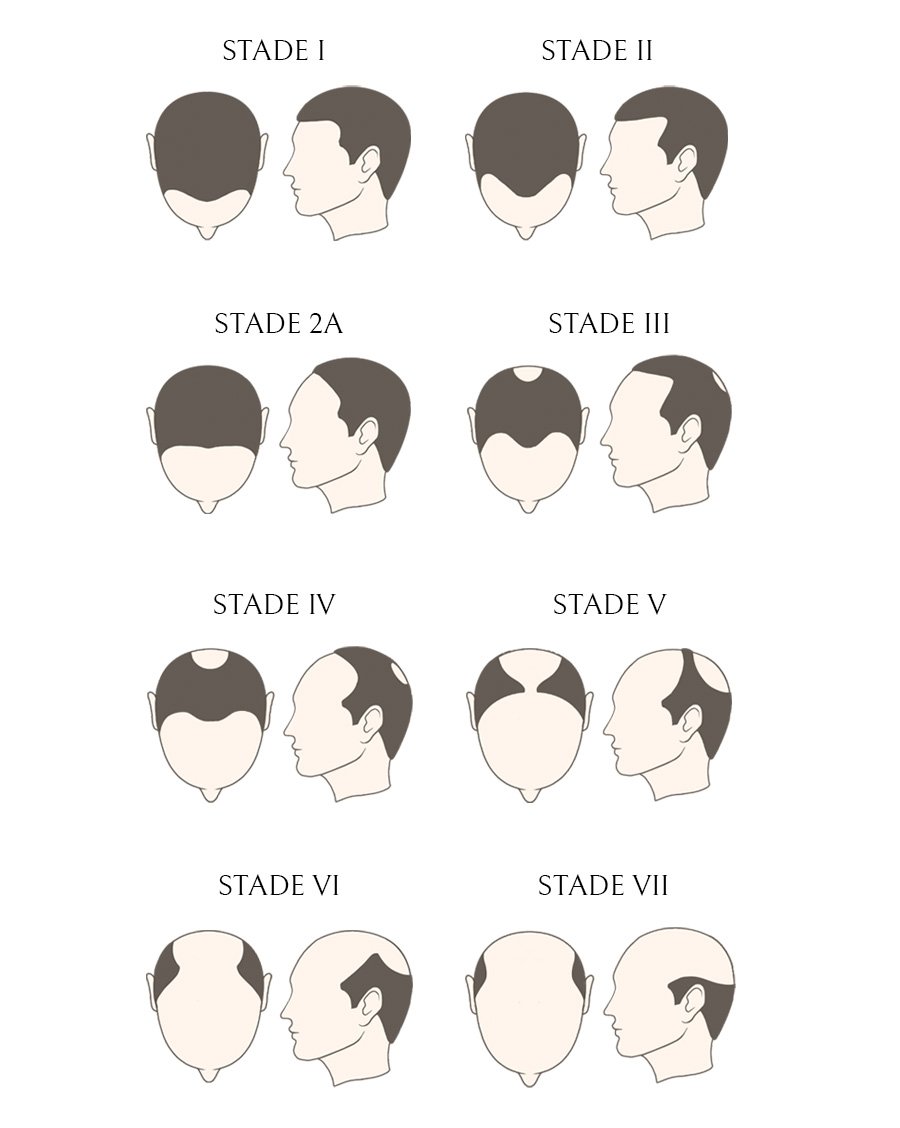

To better understand the evolution of male pattern baldness, the Norwood-Hamilton scale illustrates the 7 successive stages of androgenetic alopecia in men:
In Stage I male pattern baldness, the temporal and frontal gulfs become slightly bald, which is a signal of the onset of male pattern baldness.
In type II male pattern baldness, the deepening of the gulfs continues and may be accompanied by thinning of the vertex. The front line can start to retreat in phase 2A.
Male alopecia intensifies in stage III. The hollowing out of the gulfs becomes more and more important. Hair on the top of the upper vertex may start to disappear.
In type IV male pattern baldness, there is a deepening of the frontal temporal gulfs, as well as thinning in the central forelock and the spiral pattern. The frontal line recedes further and further, to the upper-centrale part of the head in phase 4A.
In stage V, the 3 bald areas come together. The top of the head is completely bald in phase 5A.
Stage VI of male pattern baldness corresponds to the posterior deepening of the vertex and its spiral pattern, and to a lateral loss of hair above the ears.
In stage VII, the evolution of baldness in men ends in Hippocratic alopecia. Only the lower parts of the wreath – at ear level and at the back of the head, above the neck – remain. All the hair on the top of the head has permanently fallen out.

In the 1950s, James Hamilton was the first to classify the successive levels of evolution of male alopecia, discovering a correlation between hair loss and male hormones, notably testosterone, as well as genetic predisposition.
Hippocrates himself, as far back as Antiquity, noted that castrated men did not suffer from hair loss, unlike most adult men.
In the 1970s, O'Tar Norwood refined Hamilton's grading system, now known as the Norwood Scale, by adding several intermediate stages for a more accurate measurement of male pattern baldness.
The Ludwig scale distinguishes the 3 main stages of androgenic alopecia in women, the scientific name for female pattern baldness:
Stage 1. It starts with a slight but progressive thinning at the top of the scalp. The previous front line is respected for the time being.
Stage 2. A thinning of the hair around the middle parting follows. The hair loss is increasingly clear at the top of the head, but the front hairline is still more than 3 centimetres long.
Stage 3. There is hardly any hair left in the parting area. Androgenic alopecia developed over most of the top of the head. The anterior frontal line is reduced to less than 3 centimetres, but persists slightly.
The Ludwig scale is therefore a way of classifying female alopecia, making it possible to choose the appropriate hair treatment for each stage.

The Ludwig scale distinguishes 3 main stages of androgenic alopecia in women, the scientific name for female pattern baldness:
Stage 1: It begins with a slight but progressive thinning at the top of the scalp. The front hairline is respected for the time being.
Stage 2: A thinning of the hair around the middle parting follows. The hair loss is increasingly clear on the top of the head, but the anterior hairline is still more than 3 centimetres long.
Stage 3: There is almost no hair left in the parting area. The androgenic alopecia has now developed over most of the top of the head. The anterior hairline is reduced to less than 3 centimetres, but persists slightly.
The Ludwig scale is therefore a way of classifying female alopecia, allowing the appropriate hair treatment to be chosen for each stage.

With the Norwood scale and the Ludwig scale, each person can assess his or her degree of baldness. At Maison Lutétia, this information is useful to our hair specialists in order to direct each patient towards the hair treatment best suited to his or her needs, among the various solutions.
The DHI hair transplant method is a suitable solution for many stages of baldness. It can be combined with the complementary MesoLed treatment in Paris.

